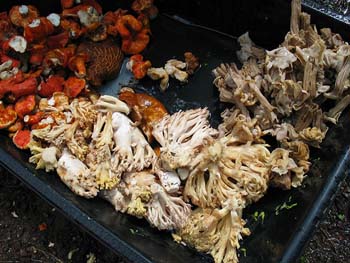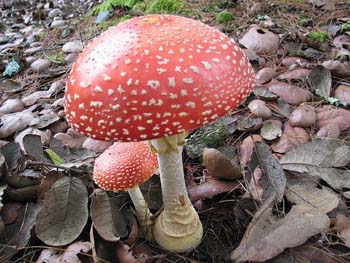During the rainy season the forest floor is spotted with a variety of mushrooms – some edible, some not. We have begun to identify the different types. To date, this is the list of the different mushrooms we have identified:
- Helvella crispa (oreja de ratón blanca)
- Hypomyces lactifluorum (trompa)
- Agaricus augustus (codorniz)
- Amanita caesarea (hongo amarillo)
- Amanita fulva (cucuchikua terekua)
- Amanita muscaria (azúcar)
- Hygrophoropsis aurantiaca (flor de durazno)
- Hydnopolyporus palmatus
- Laccaria laccata (sikitereko)
- Lactarius indigo
- Phylloporus rhodoxanthus
- Russula emetica
- Hydnum imbricatum
- Boletus edulis
We harvest coral mushrooms, trompas, and orejas de ratón for eating (pictured below). We have had success drying orejas de ratón using heat from the fire at night. These mushrooms are very tasty! We have plans to build a solar dryer for next season so we can enjoy these mushrooms after the rains have stopped.

We also have begun a project to help neighboring lot owners in Erongarícuaro inoculate their lands with mushroom micillium. We are protecting all mushroom habitats in order to encourage high growth this year and years to come! Using the book Growing Gourmet & Medicinal Mushrooms by Paul Stamets, we are investigating the ways in which we can grow mushrooms more effectively.
We do not have any psilocybin mushrooms, and would prefer that visitors do not try to use our attractive yet poisonous amanita muscaria (pictured below) for intoxication – it is very bad for your internal organs!

[…] Read about the list of mushrooms at the Bosque here. […]
I remember seeing an Amanita muscaria last year right around el dia de los muertos….I wish I had a camera, a beautiful site if not a bit deadly. 😛 Las orejas de ratón were “bien sabrosas” as well I remember from eggs made during our stay last time! 🙂
Amanita muscaria is not bad for your internal organs.
http://en.wikipedia.org/wiki/Amanita_muscaria#Toxicity
The beautiful photograph of the Amanita muscaria mushroom led me to your site. Who was the photographer?
I have finished a book titled Breaking The Mushroom Code, Mushroom Imagery in Pre-Columbian Art, on line at mushroomstone.com. I plan to use some images of the Amanita to demonstrate that this infamous mushroom was encoded in pre-Columbian art.
My study was inspired by a theory first proposed by my father, the late Maya archaeologist Dr. Stephan F. de Borhegyi, that hallucinogenic mushroom rituals were a central aspect of Maya religion. He based this theory on his identification of a mushroom stone cult that came into existence in the Guatemala Highlands and Pacific coastal area around 1000 B.C. along with a trophy head cult associated with the Mesoamerican ballgame.
Carl de Borhegyi
Nice site.
Other Amanita shots are here: http://www.flickr.com/photos/brianfey/tags/amanitamuscaria
and here:
http://www.flickr.com/photos/thebosque/tags/amanitamuscaria
You could use some of the images for your book. Check first to ask about individual ones you like so I can make sure I have rights to that one, and I can get you higher resoluton versions if needed.
-Brian Fey